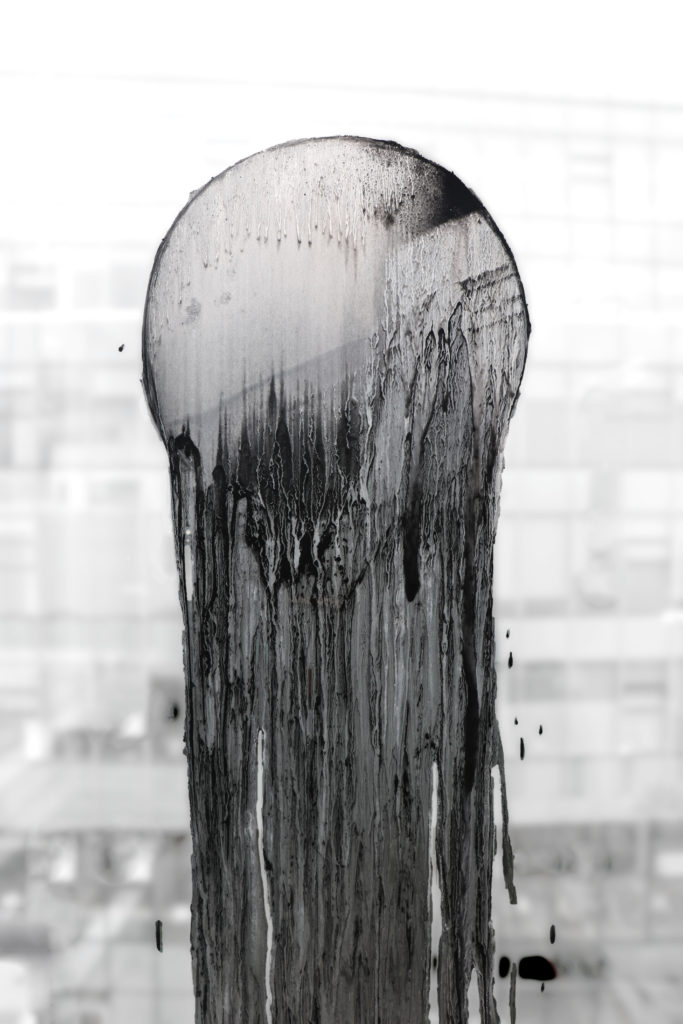Chroma is the perceived strength of a surface colour, the degree of visual difference from a neutral grey of the same lightness…. Chroma is defined as “colorfulness” of an object relative to the brightness of a white object similarly illuminated, which allows for the fact that a surface of a given chroma displays increasing colorfulness as the level of illumination increases. —David Briggs, “The Dimensions of Colour”
 Rebecca Bair, Collaboration With The Sun, 2019. Shea butter and charcoal drawing on Plexiglas, 1.82 x 1.21 m.
Rebecca Bair, Collaboration With The Sun, 2019. Shea butter and charcoal drawing on Plexiglas, 1.82 x 1.21 m.
Though we have been planning this issue since the fall of 2019 (and, arguably, have been dedicated to this work for most of our careers), we were aware that Chroma would be viewed within the longue durée of Black artists, curators and writers who have worked against their marginalization to establish their own cultural spaces while continuously engaging with this country’s shifting cultural and social imaginaries. More recently, the twin pandemics of systemic racism and COVID-19 have brought to the fore societal inequities that touch all sectors of life and work. The loss of a “normal” has created the potential for rapid, dramatic change. These two realities formed the environment in which Chroma was developed and assembled. Prior to working on this issue, we organized Bodies Borders Fields, a symposium to consider how legacies of Black art and Black presence are omitted from this country’s contemporary art narratives. Although the conference was formal by design, the three days of panels, workshops, performances and discussions forged a community that was equal parts generative, critical and supportive. We hope to invoke and continue such a nourishing atmosphere with Chroma.
Of the artists, researchers and organizers featured in this issue, many expand their interdisciplinary art practices to include the work of community-building and advocacy. In this way they incorporate the collectivity, mentorship and knowledge-sharing that are absolutely necessary for many Black creatives working across the country.
Keynote gathers comments by those who have been working toward change and privileging Black thought and Black art in academic and art institutions. With Spotlight, usually reserved for an overview of emerging artists, curator Sally Frater expanded the criteria to include overlooked practices. Poet and organizer Cecily Nicholson writes about The Cheeky Proletariat, a small community gallery in Vancouver’s Downtown Eastside neighbourhood. Chantal Gibson contributes a poem about Black life and its legacies within art history. Tiana Reid examines the genealogy of Tau Lewis’s sculpture. Adam Lauder traces the influence of 19th-century painter Robert S. Duncanson’s abolitionist landscapes. Nicholas Croggon surveys the lineage and reach of an interdisciplinary, collective, activist practice through the work of Aldo Tambellini, one of the roundtable participants in the 1967 “black issue” of artscanada. Tim Whiten’s artist project, “Dialogue: a gesture in two directions,” intervenes midway through the issue. Denise Ryner examines place as an index for the absent worker in the photographs of Stan Douglas. Kelsey Adams chronicles Nova Scotian curator David Woods’s pedagogy and advocacy in service of recentring local Black creative practice and history. Closing the issue, the organizing committee of the Black Curators Forum outlines some essential points for change for Black arts professionals to achieve equity in the culture sector.
The cover image of the Chroma issue is a portrait of poet and essayist M. NourbeSe Philip taken by poet and photographer S*an D. Henry-Smith. Philip is an example of a Black thinker whose presence and work have been routinely overlooked by Canada’s cultural gatekeepers. Philip’s conversation with Henry-Smith and Imani Elizabeth Jackson in this issue’s Dialogue section is exemplary of diasporic connections across geographies, disciplines and generations. A part of our decision to name this issue Chroma is to avoid monolithic and overly prescriptive descriptions of “black.” As Philip says, “What marks the lives of Black people, African-descended people, is what I call excess—a quality of being ‘more than.’” Blackness, and Black creative practice, has survived through its excesses and refusals. This is how we think about Blackness. Like chroma, it is more about difference than any singular colour. The entire issue escapes singularity.
As Nicholson writes on Black aesthetics in Canada, “What has been built still struggles to hold, to be visible and meaningfully present.” This issue cuts a path between emergent and sustaining communities of artists and arts workers. It is by no means an all-encompassing index of the influential and innovative work that defines the cultural output and thought of Black artists in Canada. Following Reid’s remarks on the “Caribbean mode of rigorous study of shared roots,” we note that this list of peers and progenitors is incomplete. We acknowledge significant absences, and hope these can be openings for readers to continue thinking about and learning from Black life and Black creative practices. On this note, we feel it important to nod to the trailblazing work of Andrea Fatona. As a curator, thinker and mentor, she has consistently engaged the realities of Black cultural production in Canada, particularly through community education and support. In the wake of global demonstrations of solidarity against anti-Black violence, art institutions have undergone a period of reckoning and reflection about the communities and peers they have marginalized. We hope this issue is one of many resources that lead to the building of better relationships and support for Black artists, curators and arts organizations.








